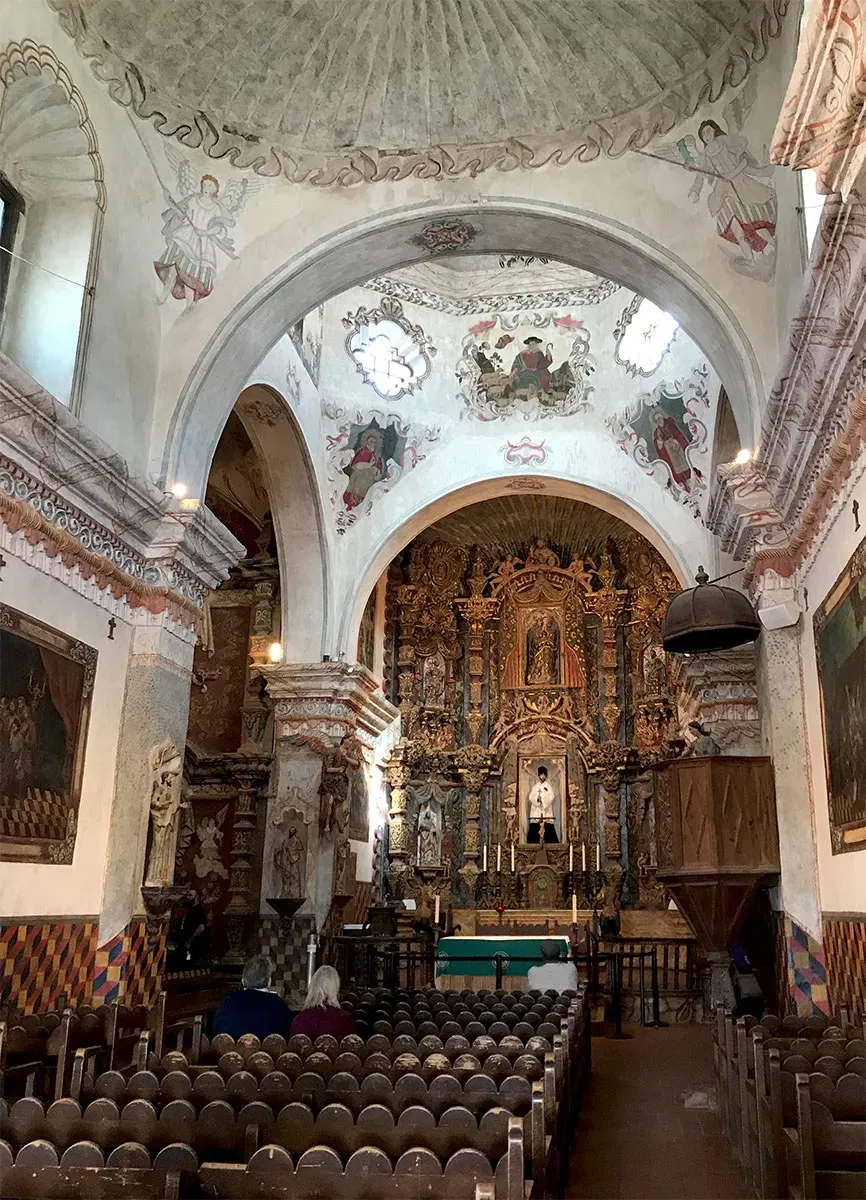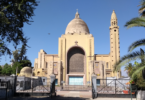
Introduction
Mission San Xavier del Bac (Spanish: La Misión de San Xavier del Bac) is a historic Spanish Catholic mission located about 10 miles (16 km) south of downtown Tucson, Arizona, on the Tohono O’odham Nation San Xavier Indian Reservation. Founded in 1692 by Padre Eusebio Kino, the mission stood at the heart of the Sobaipuri O’odham settlement along the Santa Cruz River. Named after Francis Xavier, a Christian missionary and co-founder of the Jesuit Order, the original church was situated north of the current Franciscan church and served the mission until it was destroyed during an Apache raid in 1770.
The surviving mission, constructed between 1783 and 1797 with labor provided by the O’odham people, stands as Arizona’s oldest European structure. Notable for its Spanish Colonial architecture, Mission San Xavier del Bac welcomes approximately 200,000 visitors annually. Renowned as a pilgrimage destination, thousands journey to the site each year, some arriving on foot or horseback, often as part of ceremonial cavalcades or cabalgatas.
Referred to in the O’odham language as “goes in” or “comes in,” the site denotes “where the water goes in,” owing to the Santa Cruz River’s flow, which emerged a few miles south of Martinez Hill and then submerged again near Los Reales Wash. While the river once ran consistently year-round, it now flows only intermittently, having been crucial for the community’s sustenance in the past.

Mission San Xavier del Bac was founded in 1692 by Eusebio Francisco Kino, who established a series of Spanish missions in the Sonoran Desert. As a Jesuit hailing from Italy, Kino frequently visited and preached in the area, which was part of the Pimería Alta colonial territory of the Viceroyalty of New Spain. Construction of the initial mission church, situated approximately 2 miles (3 km) from the present-day site, commenced on April 28, 1700, as documented in Kino’s diary. However, due to the threat of Apache raids, construction was halted until 1756, when it resumed under Alonso Ignacio Benito Espinosa. By 1763, the building was sufficiently completed to host services, despite encountering architectural challenges due to a poorly prepared foundation.
In 1767, Charles III of Spain expelled the Jesuits from Spanish territories in the Americas, replacing them with Franciscans. Francisco Garcés was assigned to San Xavier del Bac until 1778. Despite the protection provided by the Presidio San Agustín del Tucsón from Apache raids since 1775, the original church succumbed to attacks by 1770. The current mission building was then constructed under the guidance of Franciscan fathers Juan Bautista Velderrain and Juan Bautista Llorenz between 1783 and 1797. Architect Ignacio Gaona, funded by a loan from a Sonoran rancher, led a large team of O’odham workers to complete the church.
Following Mexican independence in 1821, Alta California fell under the jurisdiction of Mexico City. In 1822, the mission came under the Catholic Diocese of Sonora, but in 1828, all Spanish-born priests were banned by the Mexican government, leading to the departure of the last resident Franciscan in 1837. Over time, the mission deteriorated until local O’odham took it upon themselves to preserve what remained. With the Gadsden Purchase in 1853, the mission became part of the United States, and in 1859, it was reopened under the jurisdiction of the Santa Fe Diocese. Repair works were initiated, and in 1868, the Diocese of Tucson was established, ensuring regular services resumed at the church.
In 1872, the Sisters of St. Joseph of Carondelet initiated a school at the mission for Tohono O’odham children, and repairs were funded in 1895. Additional classrooms were added in 1900, and the Franciscans returned in 1913. A new school was constructed in 1947 adjacent to the church to serve the local community.

San Xavier has an elegant white stucco, Moorish-inspired exterior,[dubious – discuss] with an ornately decorated entrance. Visitors entering the massive, carved mesquite-wood doors are often struck both by the coolness of the interior and the dazzling colors of the paintings, carvings, frescoes, and statues. The architecture is entirely European, with no Piman influence on its Baroque style.
The floor plan of the church resembles the classic Latin cross, with a main aisle separated from the sanctuary by the transept, which has chapels at either end. The dome above the transept is 52 feet (16 m) high, supported by arches and squinches. At least three different artists painted the artwork inside the church. It is considered by many to be the finest example of Spanish mission architecture in the United States.
Renovation
Commencing in 1992 and still ongoing as of 2021, extensive restoration efforts have restored the mission interior to its former grandeur. The introduction of cement-based stucco in the 1980s had inadvertently trapped moisture inside the church, leading to damage to its interior adornments. This stucco is currently being removed and substituted with traditional mud plaster containing pulp from the prickly pear cactus. While this material facilitates better airflow and allows excess moisture to escape, it necessitates more frequent monitoring and entails higher maintenance expenses. Through thorough and continuous restoration work on the decorations, the interior of the mission church now resembles its original state, showcasing vibrant colors and intricate designs.

Mission Today
Unlike the other Spanish missions in Arizona, San Xavier remains under the active administration of Franciscans, continuing its service to the indigenous community for which it was originally constructed. Widely regarded as the epitome of Spanish Colonial architecture in the United States, the Mission welcomes approximately 200,000 visitors annually. It is accessible to the public daily, except during church services. The Franciscan Sisters of Christian Charity, who have been involved in education at the school since 1872, persist in their mission and reside in the convent on the mission grounds. Additionally, the mission houses a mausoleum open to visitors. Notably, the mission is mentioned in Willa Cather’s 1927 novel Death Comes for the Archbishop, where it is described as “the most beautiful church on the continent,” despite having been neglected for more than two hundred years.
Declared a National Historic Landmark in 1960 and listed on the National Register of Historic Places in 1966, Mission San Xavier del Bac holds the annual San Xavier Festival, featuring a torch-light parade of Tohono O’odham and Yaqui tribal members held the evening of the Friday after Easter.
Martinez Hill
Located to the east of the San Xavier Mission, adjacent to the I-19 Freeway, lies Martinez Hill. Historian David Leighton attributes the name of this hill to Jose Maria Martinez, a prominent figure born in the Pimería Alta in the early 1800s. Around 1833, Jose married Felipa Yrigoyen, likely in Tubac, Sonora. The couple had several children, including Maria and Nicolas Martinez. From 1836 to 1838, Lt. Col. Jose Maria Martinez served as the commander of the presidio in Tucson. Following his retirement from the military in 1838, he was granted land in Tubac. However, a decade later, an Apache attack led to the abandonment of Tubac by its residents, prompting the Martinez family to relocate to San Xavier. There, Jose was granted land by the local chief, and it is believed that Martinez Hill was either part of this land grant or in close proximity to it. Engaged in the cattle business for many years, Martinez ultimately succumbed to wounds sustained in an Apache attack in 1868.
Los Reales
To the north of San Xavier Mission lay the Los Reales community, which is thought to have thrived from the early 1860s until around 1912, though it had largely faded from memory until historian David Leighton shed light on it through an article in the Arizona Daily Star. The community was established when a miner named S.R. Domingo erected a residence and foundry just north of San Xavier Mission, on the western bank of the Santa Cruz River. Flourishing in his mining pursuits, Domingo reportedly stashed his wealth in the tall grasses along the riverbank, as banks were nonexistent at the time. As more settlers arrived and began farming the fertile valley nourished by the ever-flowing river, the community expanded. Adobe homes were constructed, crops were planted, and the original Los Reales community took shape. Unfortunately, Domingo’s life met a tragic end in the late 1860s, allegedly at the hands of miners he had employed, leaving the fate of his riches uncertain.
In 1874, President Ulysses S. Grant designated the San Xavier Indian Reservation, leading to the displacement of non-Native Americans from Indigenous lands. These individuals relocated to a new settlement, dubbed the second Los Reales, on the eastern bank of the river. This new community, opposite the original Los Reales, boasted two stores and a nearby blacksmith shop. The Los Reales Cemetery was also established on this side of the river. By 1912, the farming village ceased to exist, likely due to diminished water supply resulting from the establishment of Midvale Farms (now the Midvale Park neighborhood), leading to the demise of the old town. Today, remnants of the original community are limited to parts of the cemetery and a thoroughfare known as Los Reales Road.
Feast Day
Feast Day : 03 December
Mission San Xavier del Bac in Tucson celebrates its main feast on December 3rd, honoring St. Francis Xavier. There’s also a local festival held on the Friday after Easter, featuring traditional celebrations by the Tohono O’odham and Yaqui tribes.
Mass Timing
Monday to Friday : 6:00 am
Saturday : 5.00 pm
Sundays : 10:00 am & Noon
Church Visiting Hours
Monday to Sunday : 9:00 am, 4:00 pm
Contact Info
1950 W San Xavier Rd,
Tucson,
AZ 85746,
United States.
Phone No.
Phone: +1 520-294-2624
Accomodations
Connectivities
Airway
The nearest major airport to the Mission San Xavier del Bac Tucson is Tucson International Airport. which is 7 miles away from the Shrine.
Railway
The nearest Railway Station to the Mission San Xavier del Bac Tucson is Tucson Amtrak Station. which is 10 miles away from the Shrine.







